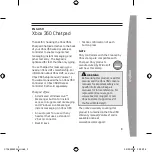
mask the level differences caused by the test steps, the antenna will not track the satellite
properly.The step size is specified as a percentage of the antenna's half 3dB beamwidth.
The ACU calculates the beamwidth from the antenna diameter and the beacon frequency.
Expressing the step size in this relative way keeps the value in the same range, regardless
of the type of antenna. The recommended value for this parameter is 15-20%. You may want
to start with 20% and try to reduce down to 15% if the signal degradation during tracking
becomes too high.The tracking step size is a common parameter for both axes. If both axes
behave differently, you can tweak the antenna diameter settings in the setup. Specifying a
larger diameter makes the ACU using a smaller step size for this axis.If the tracking step
seems to be completely out of range, you should check if the beacon frequency is set
properly. The frequency must be the true receive frequency at the antenna, entered in MHz,
not an L-band frequency or other IF.
Trackingcycletime --- The cycle time specifies how often the ACU shall perform a step track
cycle. The value is to be entered in seconds. In fact, the parameter does not specify a cycle
time but the sleep time between two tracking cycles. This means, the true cycle time is the
time the ACU needs to perform one step track cycle plus the time entered here. 300 seconds
(5 minutes) is a good starting value for this parameter. Inclined orbit satellites probably will
require a shorter cycle time, very stable satellites can be perfectly tracked with one step
track cycle every 15 minutes (900 seconds). The maximum cycle time accepted by the ACU
is 1638 seconds.
Measurementdelay --- During a steptrack cycle, the ACU positions the antenna to a
certain offset and then measures the level. Between the moment when the antenna reached
commanded position and the beacon level measurement the ACU waits some time to let the
beacon level settle. The optimal delay value depends on the beacon receiver's averaging /
post detector filter setting and is a quite critical for the steptrack performance.If the delay is
too short, the beacon voltage does not reach its final value, the steptrack does not properly
recognize if the signal goes better or worse after a test step. If the delay is too long, the
impact of fluctuation to the measures level grows and may cover the small level difference
caused by the test step. With the sat-nms LBRX beacon receiver, best results are achieved
if the receiver is set to 0.5 Hz post detector filter bandwidth and a measurement delay of
1500 msec.
Recoverydelay --- After the ACU has done the tracking steps for the elevation axis, it waits
some time before it starts tracking the azimuth axis. This is to let the beacon level settle after
the final position has been found. A typical value for this parameter is 4000 msec.
Levelaveraging --- When measuring the beacon level, the ACU takes a number of samples
and averages them. The standard value of 5 samples normally should not be changed.
Larger values will slow down the ACU execution cycle.
Levelthreshold --- If the beacon level falls below this threshold value, the ACU does not
perform a step track cycle. If the level falls below the threshold during the steptrack cycle,
the cycle gets aborted.If the ADAPTIVE tracking is enabled and there is enough data in the
tracking memory, the ACU computes a mathematical model from the stored data and predicts
the antenna pointing position from the extrapolation of the model. If the tracking mode is set
to 'STEP', the ACU leaves the antenna where it is if the beacon level drops below the
limit.Adjusting the threshold level that adaptive tracking is switched as expected must be
done carefully and may require some iterations, specially if the beacon is received with a low
C/N. A good starting value for the threshold is 10 dB below the nominal receive level or 2 dB
above the noise floor the beacon receiver sees with a depointed antenna, whatever value is
higher.To turn off the monitoring of the beacon level (this in fact inhibits the adaptive
tracking), simply set the threshold the a very low value (e.g. -99 dBm)
Smoothinginterval --- This parameter controls the smoothing function. Setting it to zero
disables smoothing. Smoothing lets the ACU point the antenna to positions evaluated from a
(C) 2022, SatService GmbH
www.satnms.com
ACU-ODU-DC-UM-2209 Page 26/67
















































